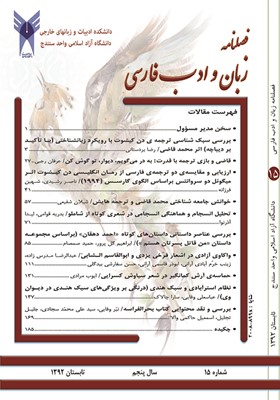ساقی نامهی نظامی گنجهای و تعداد واقعی ابیات آن
محورهای موضوعی : زبان و ادب فارسی
سیداحمد پارسا
1
*
![]() ,
محمدآزاد مظهری
2
,
محمدآزاد مظهری
2
1 - عضو هیأت علمی دانشگاه کردستان
2 - دانشگاه پیام نور مرکز تهران
کلید واژه: نظامی گنجهای, ساقی, مغنّی, باده, ساقینامه, مغنّینامه, saghi (cupbearer), moghanni (singer), wine, Sâ, ghinâ, meh, Moghanninâ, meh, Nezâ, mi Ganje', e,
چکیده مقاله :
ساقینامه یکی از گونههای شعر پارسی است که بیشتر در قالب مثنوی و در بحر متقارب مثمّن محذوف سروده شده است و شاعر در آن با مخاطب قرار دادن ساقی و مغنّی دلیل فرا خواندن آنها را بازگو میکند. هدف پژوهش حاضر، بررسی ساقینامهی نظامی گنجهای است. در این راستا ضمن بررسی دلایل فرا خواندن ساقی، تصاویر مورد استفادهی شاعر از می و میگساری، تعداد واقعی ابیات ساقینامه و مغنّینامهی نظامی و انگیزهی او از سرایش اینگونه شعر مورد بررسی قرار میگیرد. تکنیک مطالعه در این مقاله تحلیل محتوا ست و مطالب و شواهد مورد نظر به شیوهی کتاب خانهای و سند کاوی گردآوری شده است، نتیجه نشان میدهد با این بررسی میتوان به درک درستتر از ساقینامهی نظامی دست یافت.
Sâghinâmeh (bacchanalian verse) is one of the varieties of Persian poetry which has been mostly composed in the form of mathnawi and in bahre motaghâreb mothamman mahzoof, and the poet while addressing sâghi (cupbearer) and the moghanni (singer), he recounts the reasons why he summons them. The aim of the present research is to analyze Nezâmi Ganje'e's Sâghinâmeh in which the reasons for summoning sâghi (cupbearer), the poet's images about wine and drinking it, the real number of verses in Nezâmi's Sâghinâmeh and moghanninâmeh and his motive for composing this kind of poetry will be discussed. The method of study in this paper is the analysis of content, and its supporting evidence has been collected via library research and text analysis. The results demonstrate that it is probable to achieve better understanding of Nezâmi's Sâghinâmeh through this analysis.
1- ابو نواس (1986 )دیوان خمریات، با مقدّمه و شرح دکتر علی نجیب عطوی، چاپ اوّل، بیروت: دار و مکتبة الهلال.
2- جوکار، منوچهر؛ « ملاحظاتی در ساختار ساقینامه با تأکید بر دو نمونهی گذشته و معاصر»؛ پژوهش های ادبی، دورهی شماره 12- 13، تابستان و پاییز 1385، صص 122- 99.
3- حافظ، شمسالدّین محمّد(1381)دیوان، به سعی هوشنگ ابتهاج (سایه)، چاپ یازدهم، تهران: نشر کارنامه.
4- دستگردی، وحید(1363)[مصحح] کلیات حکیم نظامی گنجوی، چاپ دوم،تهران:مؤسسه مطبوعاتی علمی
5- دهخدا، علیاکبر(1377) لغتنامه، تهران: انتشارات دانشگاه تهران.
6- رستگار فسایی، منصور(1380) انواع شعر فارسی، مباحثی در صورتها و معانی شعر کهن و نو پارسی، چاپ دوّم، شیراز: انتشارات نوید.
7- صفا، ذبیحالله(1369) تاریخ ادبیّات ایران، جلد سوم، چاپ پنجم، تهران: انتشارات فردوسی.
8- صفا، ذبیحالله(1363)تاریخ ادبیّات ایران، جلد پنجم، بخش یکم، چاپ دوّم، تهران: انتشارات فردوسی.
9- فخرالزّمانی قزوینی، عبدالنبّی(1363) تذکره میخانه، چاپ چهارم، تهران، انتشارات اقبال.
10- گلچین معانی، احمد(1359) تذکره پیمانه، در ذکر ساقینامهها و احوال و آثار ساقینامهسرایان، (ذیل تذکرهی میخانه)، مشهد: انتشارات دانشگاه مشهد.
11- گلچین معانی، احمد(1363)[مصحح]تذکره میخانه،چاپ چهارم،تهران:انتشارات اقبال
12- ماهیار، عبّاس(1373)مرجعشناسی 1، چاپ هفتم، تهران: انتشارات پیام نور.
13- منوچهری، دامغانی (1361)دیوان، به کوشش دکتر محمددبیر سیاقی، چاپ پنجم، تهران: انتشارات زوار.
نظامی، گنجوی(1363)کلّیات، به تصحیح وحید دستگردی، چاپ دوّم، تهران: مؤسسهی مطبوعاتی علمی.
_||_
